Draw-Go decks created one of the original playstyles in Magic – one so fundamental their earliest incarnation was just called “The Deck.” Their most recent incarnation is called Simic Flash, and it has received some significant upgrades from Throne of Eldraine! In a Standard format heavily warped by Teferi, Time Raveler, this is the deck to sleeve up if you want to play your Magic on your opponent’s turn.
SETTING THE AMBUSH
To look more closely at how U/G Flash has gained respect, let’s check the core suite of cards. The reason the deck has been dubbed “Simic Flash” and not “Simic Control” is that all its spells can be cast at instant speed, even the creatures. Being able to see what your opponent does with their turn before deciding between your answer and your threat will grant you a tremendous advantage.
Four open mana representing both Frilled Mystic and Nightpack Ambusher is the strongest situation for U/G Flash, ensuring you move ahead on board regardless of what they do. The natural response of most opponents to heavy countermagic – save up their spells for one big turn – is heavily discouraged because not offering a spell to counter leaves Simic Flash open to cast Ambusher on the end step. The alpha wolf takes over games extremely quickly, but even Frilled Mystic can be a game-winning threat if Simic Flash can keep the board clear.
These two cards inform our deckbuilding – we need early disruption to ensure our four-drops are gamewinners, and ideally every spell will be an instant or have flash.
TELL YOUR OWN STORY
One of the biggest reasons to play Simic Flash right now is the variety of options for building it. For a reactive archetype like this, the ideal decklist is going to be different every week and in every meta. I’d like to use this opportunity to discuss some of the key options available and come to an understanding of when each is correct.
With the core of the deck built around our four-drops, the flexible slots come in at the bottom of the curve. Here’s a quick evaluation of cards competing for each role post-rotation:
Spectral Sailor

While you might underestimate this 1/1 before playing the deck, its ability forces out removal in the long, card-advantage-driven games Simic Flash creates. Must play four.
2CMC Flash Creatures
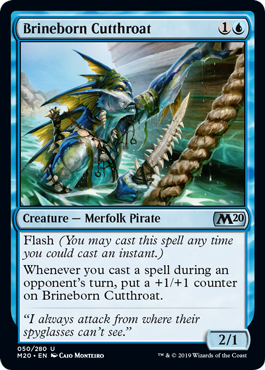
We want at least eight of these to ensure we can have a threat on the board before we start holding up mana for counters. Brineborn Cutthroat is a strong candidate to keep its place in the deck, growing more reliably than Faerie Vandal and more cheaply than Wildborn Preserver.
Cheap Counterspells
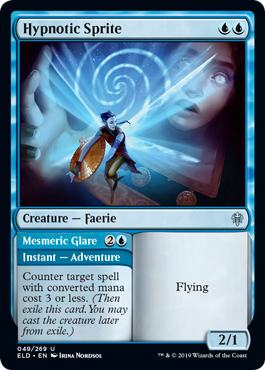
Previous versions of this deck were quite counterspell heavy, but now we have new alternatives in the form of Eldraine’s adventure creatures! We need extra counters the most turns before we have four mana, so Hypnotic Sprite is practically as good as Sinister Sabotage while also being an evasive creature. Brazen Borrower can’t provide countermagic, but its adventure bounces almost anything we’d care to counter from our opponent on turn two. The most notable exception is Teferi, Time Raveler – if you’re worried about him, try a couple copies of Quench.
Unsummon

Simic Flash’s best disruption for resolved creatures, essential on the draw. Can also pick up our Frilled Mystics for reuse or counter enemy removal. Play two or more in the main deck.
Card Selection
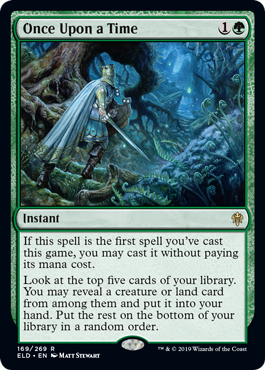
Opt played a host of minor roles pre-rotation, offering a turn-one play, an extra counter on Brineborn Cutthroat, and card selection. Once Upon A Time offers the same benefits and more power for one extra mana. Considering we can now feasibly make every other spell a creature thanks to adventures, I like the new card here. The other option is Vivien’s Arkbow, which helps us grind in the late game and plays around Teferi or countermagic.
Non-Flash Threats

The stock Simic Flash list casts everything at instant speed, and it would take a lot for me to consider changing that. These additions need to be cheap defensive options, or very powerful threats. Oko, Thief of Crowns and Mu Yanling are great examples, providing continuous advantage and mitigating enemy attacks. Gilded Goose offers a lifegain mana sink and ramp, while Vantress Gargoyle is a huge battlefield presence – though it may shine more in a similar, mill-focused U/B Flash deck.
MAKING A SPLASH WITH FLASH
Another choice to consider is whether to splash a third color in your Flash deck. With the checklands rotating out of Standard, there is a non-zero consistency cost to adding a third color, especially for allied color pairs which can’t play Temples. The non-basic lands from Throne of Eldraine offer another reason to stay in two colors, as if Frilled Mystic’s prohibitive casting cost weren’t enough.
And yet, there are still reasons you might splash. The problem has become less pronounced now that blue and green have more cheap disruption, but a lack of true removal sometimes makes it hard for us to keep the board clear. It’s especially bad to have no removal for Teferi, who single-handedly shuts us down. Even if you bounce him, you’ll have to do it on your turn, which makes it hard to stop the opponent from just replaying him and drawing another card.
Our best third color choices are black and white. Black offers Tyrant’s Scorn as an almost strict upgrade to Unsummon. We get more two-mana removal from Blacklance Paragon, which is phenomenal against aggro decks trying to get under our best spells. Paragon also applies pressure against control, although it’s still frustrated by Teferi.
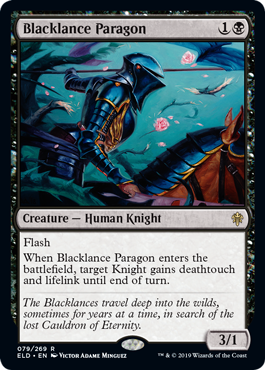
Fringe options in black include Assassin’s Trophy and cheap, scaling threats like Knight of the Ebon Legion and Piper of the Swarm. Sultai Flash also benefits from access to two Temples, which might allow us to play the ultimate creature/removal hybrid and Teferi answer, Murderous Rider.
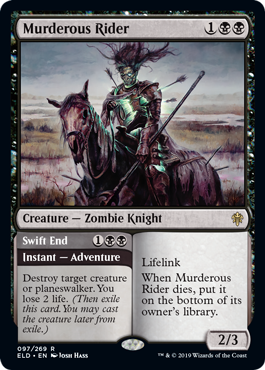
The other big splash option is white; the biggest draw here is of course Teferi, Time Raveler himself. Teferi’s static ability destroys the mirror and other reactive decks, and his -3 is perfect early interaction. White’s removal is limited (though Warrant//Warden is great), and its best creatures lack flash (Deputy of Detention, Chulane, Teller of Tales, and Tolsimir, Friend to Wolves).
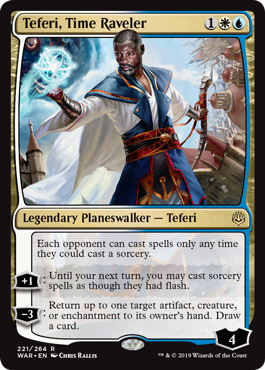
White also has sketchy mana as it lacks additional Temples, relying on Fabled Passage and shocklands instead. The solution might be Vivien’s Arkbow, which lets us circumvent color and timing requirements to play the best cards available.
A FLASHING GOOD TIME
If you’re just looking for a quick list to play and get a feel for the deck, here’s a build featuring the strongest general options. From here, you can try out splashes or some of the more fringe cards. The main deck should work fine in Best-of-One as well.

Simic Flash
4 Frilled Mystic
4 Nightpack Ambusher
4 Spectral Sailor
4 Once Upon a Time
4 Brazen Borrower
4 Brineborn Cutthroat
4 Wildborn Preserver
3 Hypnotic Sprite
3 Unsummon
2 Quench
2 Castle Vantress
4 Temple of Mystery
4 Breeding Pool
7 Forest
7 Island
Sideboard:
2 Vivien’s Arkbow
3 Mystical Dispute
3 Aether Gust
1 Selective Snare
3 Questing Beast
3 Cerulean Drake
With Throne of Eldraine, Wizards have given a green (and blue) light to this powerful and interactive archetype. And with Teferi decks on a slight decline compared to midrange value options, Simic Flash is tremendously well-positioned for these early weeks. That could change with time, but for now, I would recommend anybody to sleeve up those Nightpack Ambushers – there’s no better way to instantly climb to an early string of wins in Standard.

Tom’s fate was sealed in 7th grade when his friend lent him a pile of commons to play Magic. He quickly picked up Boros and Orzhov decks in Ravnica block and has remained a staunch white magician ever since. A fan of all Constructed formats, he enjoys studying the history of the tournament meta. He specializes in midrange decks, especially Death & Taxes and Martyr Proc. One day, he swears he will win an MCQ with Evershrike. Ask him how at @AWanderingBard, or watch him stream Magic at twitch.tv/TheWanderingBard.

